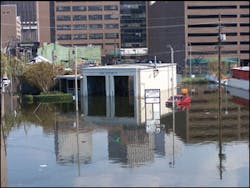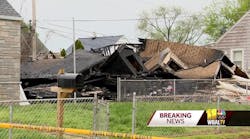Deputy Chiefs Richard Hampton and Tim McConnell of the New Orleans Fire Department provide an account of the strategic and tactical considerations faced by incident commanders before, during and after Hurricane Katrina struck the city. The interview was conducted by Firehouse Magazine Editor-in-Chief Harvey Eisner.
Through EMAC (the Emergency Management Assistance Compact), mutual aid was requested by the city through the state in Baton Rouge prior to the storm. On the afternoon of Sept. 5, 350 firefighters from FDNY and an Incident Management Team were the first to arrive. They started to respond at 6 A.M. on Sept. 6. The state of Illinois sent 500 firefighters and 40 pieces of apparatus. Montgomery County, MD, sent 80 firefighters and 10 pieces of apparatus. Units staged at the Woodland complex on the south side of the Mississippi River.
Apparently, some of the units had not known they were to be self supportive. At this complex, FDNY used Holy Cross College and the Little Sisters of the Poor facility. Illinois used tents behind Holy Cross and others used Our Lady of Wisdom Nursing Home. Other mutual aid units responded via Baton Rouge. Members of the International Association of Fire Chiefs (IAFC) worked with the command staff.
Many New Orleans fire companies were isolated or marooned. They were staged at locations designated as areas of refuge when the hurricane hit. These units performed individual or group rescues. Dispatchers also were isolated by rising water. Communications were ongoing, with crews using backup generators and batteries until backup generators were damaged and then power went down completely. Cell phones worked intermittently until service went down altogether. When the threat of flood waters was too great, the decision was made to move all companies across the Mississippi River to the southern portion of the city, in Algiers, and stage at the Woodland area. The area was large and could handle the units and manpower. It was also dry. If there were any other levee breaks, the area was still safe. It was a last place of refuge to protect the equipment and there wasn't a worry of rising water.
The radio system was dead at 6 P.M. the day of the storm. Calls were not being received. Units were conducting "windshield surveys." There were rolling fire watches, and the police were calling in fires. Companies responded to fires and made numerous rescues. When civil unrest got out of hand, the decision was made to respond only during daylight hours. Conditions were dangerous enough during the day; it was impossible to be safe at night.
When radio communications started to come back up, operations were set up at City Hall. Firefighters were resourceful in obtaining food and water. It took some time for food service staff to arrive and be able to service the personnel. At staging, all basic needs had to be set up. Food, water, EMS, prescription drugs, safety and security had to be provided. Response to alarms was made in convoy fashion with security provided by probation and parole officers.
Eventually, units operated out of the 2nd District headquarters and Engine 29's station in the French Quarter. The Incident Management Team coordinated response of FDNY, Illinois and Montgomery County. New Orleans was strapped for apparatus initially after the hurricane. Mechanics took spare apparatus out of service, fixed any problems and placed the units in service. Rigs were left behind due to mechanical problems and in rising flood waters. Other apparatus were in their safe areas of refuge and were surrounded by flood waters and could not be removed until the waters were drained.
With a minimum of apparatus and three working fires at one time, rigs had to be released from one incident and moved from fire to fire. Units were aware of many fires, but could not respond to some because of the flood waters. Fires that units could reach were responded to. At one fire, the flood waters were four to five feet high, preventing units from getting close. When we were able to get in touch with units that were marooned to see if they needed food and clothing, they said, "Leave us alone, we procured boats and we are rescuing people."
At the nursing home staging area, a huge kitchen was able to feed 450 people. Several firefighters were preparing meals for other firefighters. At the end of operations, almost 800 people a day were being fed.
We needed fuel for the rigs and had to fight to get it every day. We had to beg, borrow and plead for fuel. We contacted one person who delivered tanks of fuel. Every 12 hours, we needed 1,000 gallons of diesel and 1,000 gallons of gasoline. We located 50-gallon water tanks and used them to siphon fuel. One of the lessons learned was to get fuel from outside of the city.
Every day, we needed fuel, food, water, cooks, maintenance crews, garbage disposal, windshield repair, tire replacement and tire repair. Mechanics were needed to keep generators running. Radio and flashlight batteries needed to be charged. Louisiana State University Fire Service Training brought a trailer and portable cascade unit to refill SCBA (self-contained breathing apparatus) cylinders.
One utility needed to keep its chiller units filled when city water was lost. We responded with 10 pumpers to shuttle water to the system. Eventually, several large tractor-trailer tankers responded. Because much of the city had no water in the hydrant system, additional tankers were requested. Fireboats from the port were used at different locations, so units would not have to cross over the Mississippi River to fill up and lose valuable time in the long drive.
When units returned to the staging area, decontamination stations were set up. All units and personnel had to pass through these stations. A vendor arrived and cleaned gear.
Some amount of flood waters entered 22 of the city's 33 fire stations; some had up to 15 feet of water. Some had to be gutted and deconned.
There was a minimum of equipment in the stations. Intruders looted one station twice after it was cleaned up. Some stations will have to be torn down. Some will require major renovation. Evaluations are being conducted. FEMA (Federal Emergency Management Agency) regulations require a new station if the cost is more than 50% of the cost to rehab the station.
The city had a hurricane plan similar to many Gulf Coast and southeastern U.S. cities. Fire station equipment was to be elevated. Hospitals and nursing homes were pre-planned. Units had a place of last refuge to respond to during the storm. One unit returned after the storm went by and replaced its radios, equipment, etc. When the levee broke, flood waters rose inside the station. No apparatus were lost during the storm. Following the flooding, apparatus drove through flood waters. Because of the saltwater, rigs are being checked out daily. Some serious electric problems have developed so far.
Since the storm, 12 firefighters have resigned. Some were young and only had a few years of service. Their families have relocated and they were on the bottom of the pay scale. Some senior members say they're going to retire.
To house firefighters at damaged stations, numerous trailers have been ordered. While repairs are made, firefighters will have to live in these trailers placed at the rear of the fire stations.
Another lesson learned was to implement our own Incident Management Team. Flooding caused a lot of corrosion to fire hydrants. Each day, units responded to a certain city ZIP code to check pressure in fire hydrants. Many trees were uprooted by high winds and these caused damage to water mains. The flooding caused many gas leaks when houses were moved from their foundations. Gas shutoffs were under water. The gas company eventually had to shut off the gas to each house.






